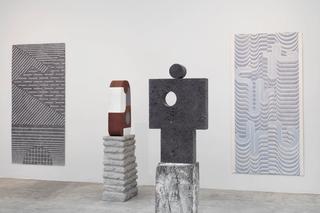Canto a un dios mineral is Pedro Reyes' fourth exhibition at Labor. This exhibition of direct carvings in stone and paintings on amate paper are an example of the solid formal vocabulary that the artist has developed in recent years.
Regarding Reyes' sculptural work, critic Daniel Garza Usabiaga has pointed out how his production continues with the anti-colonial stance present in modern Mexican sculpture, to which he commonly refers by focusing on ancient and original sources. For Reyes, suggests Garza Usabiaga, the triumph of Mexican sculpture exists the further it moves away from the European. 1
An example of this appears in Iztaccíhuatl, an onyx carving from Tecali, in which Reyes takes the pictogram of “tepetl”—“mountain” in Nahuatl—, and modifies it to match an abstraction of the sleeping woman, the unmistakable silhouette that is part of the Anahuac.
In Tlalocan, a piece carved in recinto (volcanic stone), one can appreciate contours derived from the noses and beards that characterize the pictorial and sculptural representations. Tlalocan is an abstraction of this face from which water flows.
Another point of connection with the ancient cultures of this continent appears in the tezontle carving called Isla Tortuga. The title of the piece refers to the cosmogonic myth about the Sky Woman who falls into the seas of this planet, and a turtle emerges to save her, growing to become the territory we now call North America.
The sculptural work is accompanied by a set of paintings on amate, a paper that continues to be made in the same way since 700 years ago in San Pablito Pahuatlán, Puebla. Amate was used for codices painted by tlacuilos—“scribes” or “painters” in Nahuatl—who recorded testimonies through the use of pictograms. Following this type of figurative writing system, Reyes created Cempocalli or “twenty houses”, where a tessellation of the calli pictogram generates a pattern with echoes of geometrism that integrates form and meaning.
- 1 Daniel Garza Usabiaga. “UR”.Pedro Reyes: Social Sculpture . 2024. Editorial RM













